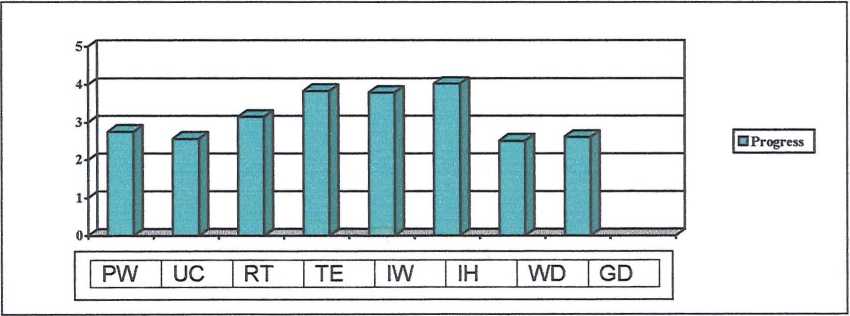116
A sense Ofprogress
Table 4.1.22 and Figure 4.1.19 below show that 8th graders believed strongly (4≤M<5)
that Individual help promoted their sense of progress. They neither agreed nor disagreed
(3<M<4) that Reading a textbook, Teacher explanation, and Individual work promoted it,
and they expressed disagreement (2<M<3) that Practical work, Using a computer,
Whole-class discussion and Group discussion promoted it. These differences were
statistically significant. A relatively wide distribution of responses existed in the extent to
which sense of progress was perceived to be promoted by all of the teaching methods
considered. 8th graders felt that only Individual help positively promoted a sense of
progress. This was one of the teaching methods reported as frequently being deployed
by the teachers of 8th graders.
Table 4.1.22: Mean scores and Standard Deviation; a sense of progress, perceptions of
8th graders
|
Practical |
Using |
Reading a |
Teacher |
Individual |
Individual |
Whole-class |
Group | |
|
N |
2143 |
2138 |
2141 |
2142 |
2143 |
2142 |
2143 |
2142 |
|
M |
2.75 |
2.57 |
3.15 |
3.83 |
3.79 ' |
4.03 |
2.52________ |
2.62 |
|
SD |
1.26 |
1.22________ |
1.26 |
1.10_________ |
1.16 |
1.15________ |
1.15________ |
1.19________ |
The result of a repeated measure ANOVA [F(8,17064)=800.79, p<.01]
Figure 4.1.19: Sense of progress promoted by different teaching methods, perceptions
of 8th graders

116
More intriguing information
1. Regional Intergration and Migration: An Economic Geography Model with Hetergenous Labour Force2. Wage mobility, Job mobility and Spatial mobility in the Portuguese economy
3. The name is absent
4. The name is absent
5. Models of Cognition: Neurological possibility does not indicate neurological plausibility.
6. The name is absent
7. The quick and the dead: when reaction beats intention
8. The Effects of Attendance on Academic Performance: Panel Data Evidence for Introductory Microeconomics
9. A production model and maintenance planning model for the process industry
10. The name is absent